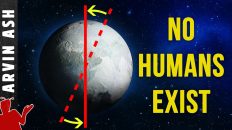What is the universe really made of? What is truly fundamental in the reality that we perceive?
In 400 BC, Greek philosopher Democritus came up with the idea of atoms as being fundamental – He believed these were solid pieces of matter which could not be divided any further.
2300 years later, in 1897, J J Thompson discovered something smaller than an atom, called the electron. And in 1912, Ernest Rutherford discovered that atoms had nuclei. Then we found that nuclei were composed of protons and neutrons. These were thought to be the fundamental components that all things are made of…until the 1960’s when we found that neutrons and protons were composed of even smaller things called quarks – two kinds, up quarks and down quarks.
Today, everything that you see around you is thought to be made of up of just these three particles – electrons, up quarks and down quarks. That’s what all atoms are made of. Your phone, your desk, your skin, grass…everything. At least this is what most people are taught in science class.
The only problem is it is not true. And physicists have known this for decades. These three particles are really not fundamental.
The best theory in physics tells us that there really are no particles at all. Nature is made of fields. Reality is fundamentally many different fields. These things we call particles are merely waves in the field. Not that kind of field though.
So what in the heck are these fields? And what do they tell us about the nature of reality?
The idea of particles, even the particles that I have talked about numerous times composing the standard model is not what the universe is actually made of. The particles are fiction. They are convenient representations and are not really the best understanding of the universe today.
The fundamental nature of the universe are not particles but fields. These are fluid-like substances that can be perturbed, they can vibrate and experience excitations.
What exactly are fields? Mathematically a field something that takes a value at every point in space. They are not really made of anything other than that from a strictly physicist’s point of view.
Think of it this way, if you have a fireplace in a room, the temperature at every point in that room would have a value. This would be a field of temperature – this is analogous to the universe’s fundamental fields.
And these fields in nature are everywhere. You cannot escape it.
If you take a strong metal box, and remove everything from it, all gases, all atoms, all photons – what will be left inside that box? This is what we think of as a vacuum, like the vacuum of empty space. But in fact this vacuum is alive with these fields. And they are constantly moving and changing.
The Heisenberg uncertainty principle means that a quantum field cannot sit still. Instead, They are moving and vibrating and changing their value over time.
This is a computer simulation of empty space. All the bubbles that you see popping and bursting are perturbations of the empty space – particles are constantly being created and destroyed in this emptiness. But these particles are really excitations of fields that pervade all of space.
What you can see in the world around you are excitations of these fields. In fact all you can see is really only the excitations of 4 of the fields.
You can see photons (or light) which are vibrations in the electromagnetic field. Electrons are vibrations in the electron field. Up quarks and down quarks make up the protons and neutrons in the nucleus of all atoms, they are vibrations in the up quark field and down quark field respectively.
Amazingly, everything that you can see around you, your phone, your desk, flowers and trees, the earth below your feet. Everything is composed of just these 4 fields.
But there are more than just these 4. In fact everything that we designated as particles in the standard model, the best theory of physics we have, are really excitations or vibrations of their own fields.
The total number of fields would be 17, including the Higgs field.
Note that space-time itself is thought to be a field, but so far has not been able to be incorporated in quantum field theory. It would be the 18th field.
All the so-called particles are really waves. And when I say wave, I don’t mean a wave like an ocean wave. This 2D models is just a visual aid, but the waves would actually be three dimensional.
Can you see any of these fields? Not really, but when you can get kind of an idea of this by putting a magnet together with some metal filings. The lines that you see are really the magnetic field lines changing due to the magnet.
Another way to visualize the fields is to Imagine the volume of the universe being filled with water as if we were living in an ocean. Now imagine that instead of water, the ocean is filled with multiple fluids, about 17 different kinds of fluids. And these fluids are of different colors.
This may look really spectacular and weird, but this is somewhat analogous to what our universe actually looks like…except that you cannot see these fluids.
Why is this theory better than the idea of particles? The key thing that fields eliminate is the idea of action at a distance.
So for example in Newtonian gravity, you have to concede that the gravity of the sun somehow affects the earth which is 120 million kilometers away. How can something affect something else so far away without touching it. This is action at a distance. Even Newton thought that action at a distance was absurd. He said, “It is inconceivable that inanimate brute matter should, without the mediation of something else which is not material, operate upon and affect other matter without mutual contact…”
Einstein’s theory of general relativity eliminated this idea of action at a distance by replacing space with something called space-time, which is a field that pervades all of reality. And he showed mathematically that gravity is really due to a bending of this field of space-time.
Whatever happens anywhere to a particle in space is governed by what is happening in the field near the particle. In order for something to propagate over distances, it has to affect its field locally, then propagate from the local point to another distant point, then affect the field locally at the distant point. This is similar to the way a wave will propagate in water if you throw a rock in it, from the rock to the shore.
Fields can also explain how particles can be created and destroyed. So for example, when a Neutron decays to a Proton, an electron, and an antineutrino – how does this happen? Was the electron hiding in there? Where did it come from.
Fields have the property that they can give their vibrations or energy away. If you shake the field hard enough, they will affect other fields. So in this decay, the energy of the quark fields of the Neutron can be transferred to the quarks fields of the Proton, plus electron field and antineutrino fields.
You are affected by these fields every day. When you call someone on your cell phone, you are putting excitations in a field and affecting the electronics within the cell phone of the person you are calling. This is action at a distance in practice, except it is not action at a distance. Your cell phone is creating excitations in the electromagnetic field, that is propagating from you to the cell tower, and eventually on to the receiver on the other end.
But there appears to be a dilemma here, because you have learned in school and in my videos too that quantum mechanics is about discreet things – that’s why it is called quantum. But fields are continuous, not discreet. So there appears to be a conflict here between the idea of discreetness of particles as presented in quantum mechanics, and the continuous nature of fields.
How are these two ideas reconciled? The combining of field theory with quantum mechanics is called quantum field theory or QFT.
So essentially, all the excitations of fields happen only in chunks of energy. The energy of the wave is determined by the mass of the particle. What is a mass? A mass of a particle is just the energy needed to vibrate its field. Energy if you recall is equivalent to mass using Einstein’s famous equation E=MC^2.
The field will simply not accept energies below a certain threshold. Once you tap the field hard enough, however, a particle is created. This discrete unit of energy that the field can accept is what we call the rest mass energy of particles in a field. It is the fundamental amount of energy that must be added to the field in order to create a particle. Some particles like the Higgs Boson, require a lot of energy to create it. That’s why the Large Hadron collider had to be built to detect it.
So for example, one electron is created when the electron field is excited by 0.511 MeV (megaelectron volts) which is the mass of one electron. If you add energy equivalent to 0.4 MeV, no particle gets created. If you put in energy of 0.7 MeV, only one electron gets created. If you put in 1.1 MeV, then two electrons get created, and so on.
The ripples in this electron field, or the 3d waves in this fluid, are little bundles of energy manifesting themselves as electrons.
All the electrons in your body and my body are waves in the same underlying field. The field is fundamental, the electrons are not. Also present in this room and your room are the up quark field and the down quark field. And all the atoms in your body are composed of particles which are ripples in these three fields. It is the same field that you, I, and everyone on earth is in. In fact it’s the same field that all the other planets and the sun is in. We are basically composed of ripples in the same 3 fields everywhere in the universe.
There is no indication that the ripples on my field can communicate with the ripples in your field, but it’s one continuous field, and everything is connected to it.
Fields don’t tell us everything though. It does not tell us what dark matter is, what dark energy is, or how the big bang occurred, or why there is more matter than antimatter in the universe.
How are waves in the field related to the probability waves of quantum mechanics and the Schrodinger equation?
when we say that an electron is a particle with a position and velocity, this is wrong. And it’s not because we can’t measure its position and velocity. It’s because there is no such thing as a position and velocity. All there is is a wave function. It is spread all throughout space and it only tells us what the position and velocity will be if we choose to measure it.
So for example, the shape of the electromagnetic field is the wavefunction of photons, the shape of the electric field is the wavefunction of electrons, and so forth.
The wave function is what really exists. But when you observe the electron, you don’t see the wave function because the wave function has collapsed into a discrete value. This can be predicted by the Schordinger equation.
The fields are vibrating and modulating, but when you measure them, they resolve into individual packets of energy, called particles. A particle has a location, but a field is spread out everywhere. So quantum mechanics says that fundamentally, reality is different when you measure it vs. when you don’t.
Every particle in the Universe — is a tiny ripple of the underlying field, moulded into a particle by the machinery of quantum mechanics.
The Quantum fields vibrating at every location in space and throughout time are the fundamental building blocks of nature.
So the age old question of whether light a particle or wave can be answered. They are waves. A particle is just what manifests when we measure the wave.
Who discovered fields? Michael Faraday came up with the idea and actually used the word “field” in his notebook in 1845.
Are fields a real thing, or are they just mathematical constructs? Even though a field is made of no substance that physicists know of, fields are considered real, physical stuff. This is because they exist in space and have energy. In addition, their properties can be calculated, and accurately predicted by experimental results.
This is the reason most physicists believe them to be physical reality.
Are these fields fundamental? Well, I think it’s fundamental in the sense that it is the limit of our understanding. It could very well be that fields are just an approximation of a deeper level of reality.
Because ultimately, there should be some fundamental reason why these fields have the properties that they do. They all obey certain mathematical rules and can be predicted by mathematical formulas. Why is this the case? Why does the electron field have a minimum requirement of 0.511 Megaelectron volts? Why does it obey mathematical rules? Will we ever know the answer, unlike many physicists, I think we will. We may not even be asking the right questions.
In the famous words of a certain secretary of defense, there are known unknowns, and unknown unknowns. And I think the answer will come, when we humans know enough to ask the right question.







